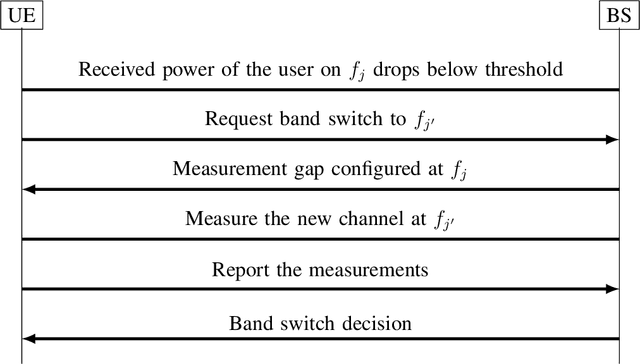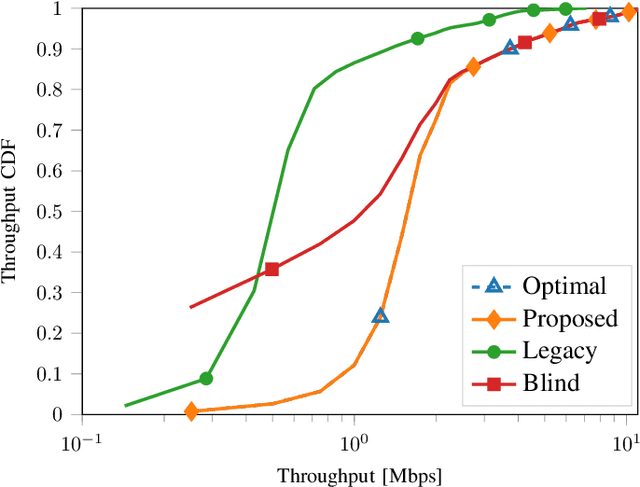Faris B. Mismar
Uncoordinated Interference Avoidance Between Terrestrial and Non-Terrestrial Communications
Apr 14, 2023Abstract:This paper proposes an algorithm that uses geospatial analytics and the muting of physical resources in next-generation base stations (BSs) to avoid interference between cellular (or terrestrial) and satellite communication systems as non-terrestrial systems. The information exchange between satellite and terrestrial links is very limited, but a hybrid edge cloud node with access to satellite trajectories can enable these BSs to take proactive measures. We show simulation results to validate the superiority of our proposed algorithm over a conventional method. Our algorithm runs in polynomial time, making it suitable for real-time interference avoidance.
Deep Learning Predictive Band Switching in Wireless Networks
Oct 02, 2019



Abstract:In cellular systems, the user equipment (UE) can request a change in the frequency band when its rate drops below a threshold on the current band. The UE is then instructed by the base station (BS) to measure the quality of candidate bands, which requires a measurement gap in the data transmission, thus lowering the data rate. We propose a band switching approach based on machine learning that does not require any measurement gap. Our proposed classifier-based band switching policy instead exploits spatial and spectral correlation between radio frequency signals in different bands based on knowledge of the UE location. We focus on switching between a lower (e.g. 3.5 GHz) band and a millimeter wave band (e.g. 28 GHz), and design and evaluate two classification models that are trained on a ray-tracing dataset. A key insight is that measurement gaps are overkill, in that only the relative order of the bands is necessary for band selection, rather than a full channel estimate. Our proposed machine learning-based policies achieve roughly 30% improvement in mean effective rates over those of the industry standard policy, while achieving misclassification errors well below 0.5%.
Machine Learning in Downlink Coordinated Multipoint in Heterogeneous Networks
Sep 02, 2018



Abstract:We propose a method for practical downlink coordinated multipoint (DL CoMP) implementation in the fifth generation of wireless communications (5G) also known as New Radio (NR). We base our method on supervised machine learning. Contributions of this paper are to 1) demonstrate that a support vector machine (SVM) classifier can learn improved conditions at which DL CoMP can be dynamically triggered in a scalable realistic environment and 2) increase user throughput in a heterogeneous network as a result of learning improved triggering conditions of CoMP. Our simulation results show an improvement in both the macro and pico base station peak throughputs due to the informed triggering of the multiple DL CoMP radio streams as learned from the SVM classifier.
A Framework for Automated Cellular Network Tuning with Reinforcement Learning
Aug 13, 2018



Abstract:Tuning cellular network performance against always occurring wireless impairments can dramatically improve reliability to end users. In this paper, we formulate cellular network performance tuning as a reinforcement learning (RL) problem and provide a solution to improve the signal to interference-plus-noise ratio (SINR) for indoor and outdoor environments. By leveraging the ability of Q-learning to estimate future SINR improvement rewards, we propose two algorithms: (1) voice over LTE (VoLTE) downlink closed loop power control (PC) and (2) self-organizing network (SON) fault management. The VoLTE PC algorithm uses RL to adjust the indoor base station transmit power so that the effective SINR meets the target SINR. The SON fault management algorithm uses RL to improve the performance of an outdoor cluster by resolving faults in the network through configuration management. Both algorithms exploit measurements from the connected users, wireless impairments, and relevant configuration parameters to solve a non-convex SINR optimization problem using RL. Simulation results show that our proposed RL based algorithms outperform the industry standards today in realistic cellular communication environments.
Deep Q-Learning for Self-Organizing Networks Fault Management and Radio Performance Improvement
Jul 31, 2018



Abstract:We propose an algorithm to automate fault management in an outdoor cellular network using deep reinforcement learning (RL) against wireless impairments. This algorithm enables the cellular network cluster to self-heal by allowing RL to learn how to improve the downlink signal to interference plus noise ratio and spectral efficiency through exploration and exploitation of various alarm corrective actions. The main contributions of this paper are to 1) introduce a deep RL-based fault handling algorithm which self-organizing networks can implement in a polynomial runtime and 2) show that this fault management method can improve the radio link performance in a realistic network setup. Simulation results show that our proposed learns an action sequence to clear alarms and improve the performance in the cellular cluster better than existing algorithms, even against the randomness of the network fault occurrences and user movements.
Q-Learning Algorithm for VoLTE Closed-Loop Power Control in Indoor Small Cells
Jul 30, 2018



Abstract:We propose a reinforcement learning (RL) based closed loop power control algorithm for the downlink of the voice over LTE (VoLTE) radio bearer for an indoor environment served by small cells. The main contributions of our paper are to 1) use RL to solve performance tuning problems in an indoor cellular network for voice bearers and 2) show that our derived lower bound loss in effective SINR is sufficient for VoLTE power control purposes in practical cellular networks. In our simulation, the proposed RL-based power control algorithm significantly improves both voice retainability and mean opinion score compared to current industry standards. The improvement is due to maintaining an effective downlink signal to interference plus noise ratio against adverse network operational issues and faults.
 Add to Chrome
Add to Chrome Add to Firefox
Add to Firefox Add to Edge
Add to Edge